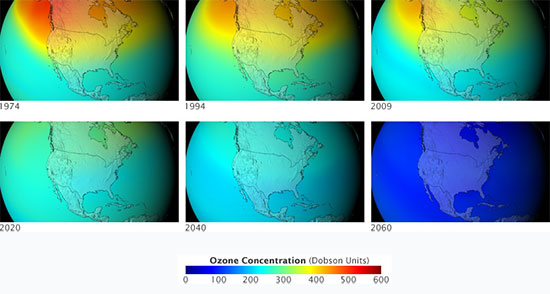Mario Molina
by Jorge Saucedo & Aymará Boggiano
Translated by Aymara Boggiano
Today what's in the air? The University of Houston's Department of Hispanic Studies presents this series about the machines that make our civilization run, and the people whose ingenuity created them.
"Traveler: you have arrived at the most transparent region of the air."
These were Von Humboldt's words when he saw the soft sunlight illuminating the mountains in the Valley of Mexico. The cleanliness of air and purity of water have always moved poets and inspired scientists, yet someone may wonder if that transparency isn't just an illusion. A more attentive look shows that an entire universe exists where there appears to be nothing. Through a microscope we see the parallel universe of unknown species that inhabit a drop of water.
Mario Molina took that very seriously. As a boy in Mexico, he saw an amoeba with his toy microscope. He was so intrigued that he asked his parents to let him install a laboratory in one of their bathrooms. With his aunt, who was a chemist, he did the same experiments that students do in the first years of college.

Illustration courtesy of Centro Mario Molina
Years later, back in a laboratory in California, this time working on a PhD and observing properties, not of water, but of air. He and his colleague Sherwood Rowland studied the effects of chlorofluorocarbons or CFCs when released in the air, an interesting challenge! It was the 70s and for more than 30 years industries had been producing CFCs in aerosols, extinguishers, and refrigerating substances. Molina and Rowland noticed that in the stratosphere CFCs were decomposed by the sun rays, and the resulting bromine and chlorine were destroying the ozone layer. This was an extraordinary discovery: if they were right, they'd found a global process harming the environment that no one had noticed, the most important thing was they knew how to stop it.
The ozone layer protects our planet against ultraviolet rays that are harmful to the environment and the leading cause of skin cancer in humans. They presented their findings to colleagues and governments in different countries, and through the media, to the general public. Later their work fueled the signing of the Montreal Protocol: the first international treaty to address an environmental challenge at a global scale. Signing such a treaty was not easy: many companies producing chlorofluorocarbons would not do costly modifications to their production because of a hole in the ozone layer that no one had seen. Indeed, it would not be detected until 1985, but the dissemination efforts of Molina and Rowland had many governments, including the U.S., already started in regulating the use and production of ozone-depleting substances.

NASA projections of stratospheric ozone concentrations if chlorofluorocarbons had not been banned.
Images courtesy of the Goddard Space Flight Center Scientific Visualization Studio
In 1995 Mario Molina along with Rowland and Crutzen received the Nobel Prize in Chemistry, for their research. Molina went on to establish a research center to help reduce pollution in Mexico, and to advise governments about air quality and sustained development. Truly, the positive effects of observing nature allow us to dream today a more transparent future.
I'm Aymara Boggiano, at the University of North Texas, where we're interested in the way inventive minds work.
(Theme music)
References:
Interview with Mario Molina: Olive Heffernan, "Mario Molina. Socially responsible science", Outlook Supplement, Nature 490, pp 14-15, 11 Oct. 2012.
Wikipedia's page on Fluorocarbons.
This episode first aired on December 4, 2013.